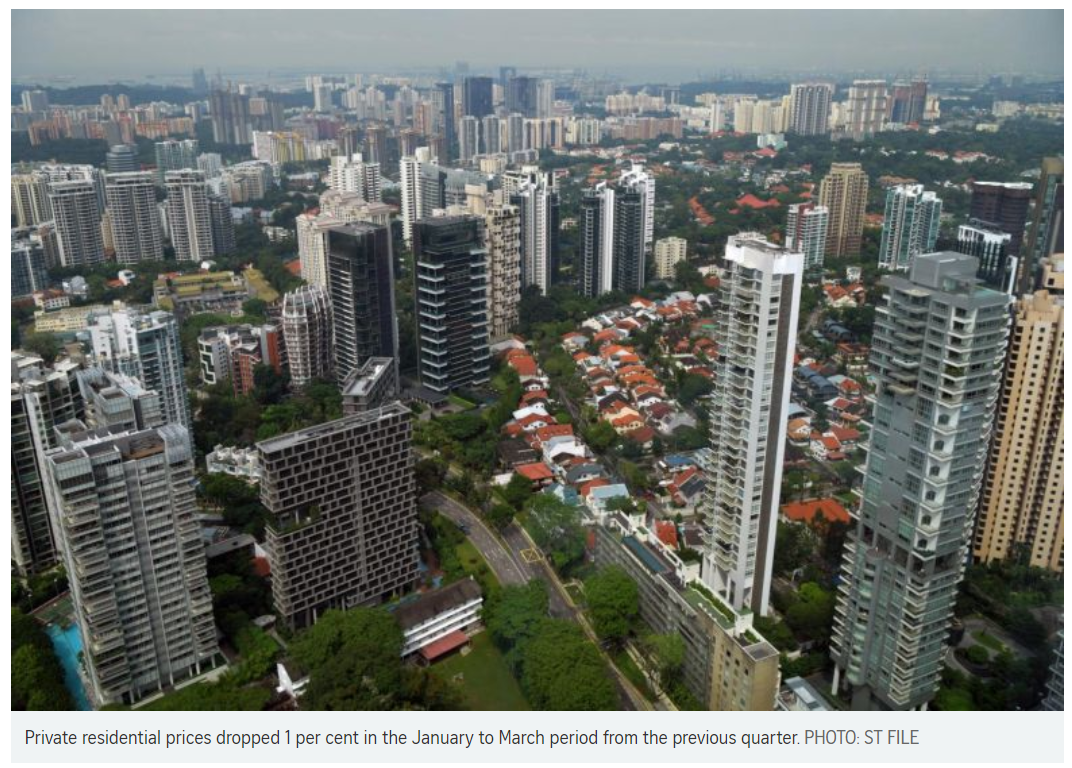Singapore: Private home prices drop 1% in Q1 before circuit breaker measures
SINGAPORE – Private home prices fell less than initially estimated in the first quarter of 2020, but Singapore’s extended “circuit breaker” period against a sharp rise in Covid-19 cases will put more downward pressure on the property market.
Private residential prices dropped 1 per cent in the January to March period from the previous quarter, according to data from the Urban Redevelopment Authority (URA) on Friday (April 24). This is slightly less than URA’s preliminary estimate of a 1.2 per cent decline at the beginning of April.
The drop comes after three consecutive quarter-on-quarter gains, with private home prices last up a modest 0.5 per cent in the fourth quarter of 2019.
Year on year, private home prices in the first quarter are still up 2.4 per cent from the same period in 2019
Before Singapore’s partial lockdown measures were introduced in the first week of April, then extended and tightened last Friday, analysts were predicting up to an 8 per cent drop in private home prices for 2020 – which would be the first yearly decline since 2016. Prices achieved a “soft landing” last year with the July 2018 cooling measures, softening by 2.7 per cent.
Ms Christine Sun, head of research and consultancy at OrangeTee & Tie, said prices of private homes may decline up to 4 per cent for the full year, though the forecast may be revised if the circuit breaker extends beyond June 1.
She added: “Although the long-term effects of the coronavirus pandemic remains uncertain, the bright side is that Singapore’s property market has always recovered after every economic crisis. Buying activities could pick up faster than other downturns given the pent-up demand from many weeks of home isolation. “
According to URA’s final data for the first quarter, prices of non-landed properties declined by 1 per cent, worse than the 0.3 per cent drop in the previous quarter.
Prices of landed homes dropped 0.9 per cent, reversing from a 3.6 per cent increase in the previous quarter.
For prices of non-landed properties by region, those in the core central region fell 2.2 per cent, compared with the 2.8 per cent drop in the previous quarter. Units in the city fringe or rest of central region dipped by 0.5 per cent, compared with the 1.3 per cent fall in the previous quarter.
Prices in the suburbs or outside central region declined 0.4 per cent, compared with the 2.8 per cent increase in the previous quarter.

The number of private homes sold fell with lockdowns around the world deterring foreign buyers and safe-distancing measures at home.
Developers sold 2,149 new homes (excluding executive condominiums or ECs) in the first quarter of this year, down by 12 quarter on quarter but up 16.9 per cent year on year. They also launched about 6 per cent fewer units – 2,093 as against 2,226 units previously.
Meanwhile, resale and subsale transactions stood at 2,120 units, a 12.9 per cent drop from the previous quarter but 11.3 per cent higher year on year.
“We believe the take-up has yet to reflect the full impact of Covid-19 as the circuit breaker measures kicked in after the quarter-end, at 7 April, and most of the transactions had occurred in January and February,” said Tricia Song, head of rResearch for Singapore at Colliers International.
She said: “With the circuit breaker extended to 1 June, we expect an impasse in April and May for developer sales. We now expect developers’ sales may fall to 8,000 units for the full 2020, compared to the 9,912 units in 2019, assuming some rebound due to pent-up demand before the year-end.”
Ms Song expects prices to decline by 3-5 per cent in 2020, nowhere close to the 24.9 per cent slide over four quarters during the Global Financial Crisis of 2008-2009.
“The nine rounds of property cooling measures in 2009-2018 have reined in speculation and price increases over the past three years were more sustainable,” she said.
Mr Nicholas Mak, ERA Realthy’s head of research & consultancy, said: “Almost two-third of the potential housing transaction volume in the second quarter of this year can be written off due to the eight-week partial lock-down. Even after the lock-down is lifted, the spread between the bids and offers of property buyers and sellers would widen due to the expected economic impact of Covid-19, resulting in fewer transactions in the coming months.”
He says prices could contract by 3 to 6 per cent this year from the expected economic slump. “All this could change once the pandemic is contained, and confidence is restored in the market,” he added.
For the rental market, URA’s data show that rents rose 1.1 per cent in the first quarter of this year, after dropping 1 per cent in the previous quarter. This came as the vacancy rate for private residential units dipped to 5.4 per cent from 5.5 per cent in the prior quarter.
Ms Sun said the spike in short-term demand likely propped up rental prices last quarter.
Private rental volume surprised on the upside as the number of transactions rose 2.4 per cent to 21,191 units. Rental renewals rose last quarter as many foreign workers required immediate lodging prior to the circuit breaker measures and lockdowns imposed by Malaysia, said Ms Sun. Many tenants were also reluctant to scout around for alternate housing to minimise the possibility of catching the virus, she added.
Source: https://www.straitstimes.com/business/property/private-home-prices-drop-1-in-q1-amid-lighter-covid-19-measures


 English
English




